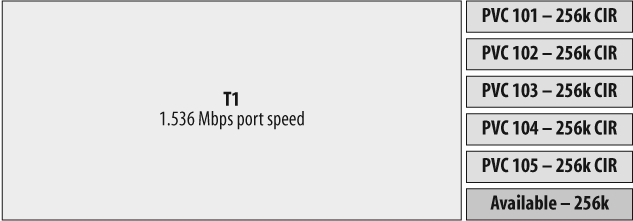Oversubscription
When designing frame-relay networks, care must be taken to ensure that the total amount of bandwidth being provisioned in all CIRs within a physical link does not exceed the port speed. A CIR represents guaranteed bandwidth, and it is technically impossible to guarantee bandwidth beyond the port speed. A frame-relay link is considered oversubscribed when the total bandwidth of all the virtual circuits within the link exceeds the port speed of the link. For example, having four PVCs each with a 512 Kbps CIR is possible on a T1, even though the total of all the CIRs is 2,048 Kbps. Some providers will allow this, while others will not.
Tip
The burst rate has no bearing on the oversubscription of a link.
Careful planning should always be done to ensure that the CIRs of your PVCs total no more than the port speed of your physical link. I use spreadsheets to keep me honest, but any form of documentation will do. Often, simple charts like the one in Figure 22-8 are the most effective.

Figure 22-8. Subscription of a T1 using frame-relay PVCs
There are no technical limitations preventing oversubscription. During the Internet boom, small ISPs often debated the ethics of oversubscription. Many ISPs routinely oversubscribed their frame-relay links to save money and thereby increase profits. Oversubscription is never good for customers, though: eventually, usage will increase to ...
Get Network Warrior now with the O’Reilly learning platform.
O’Reilly members experience books, live events, courses curated by job role, and more from O’Reilly and nearly 200 top publishers.

